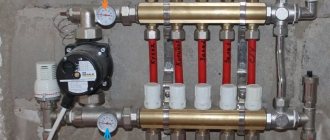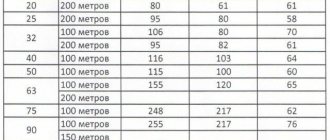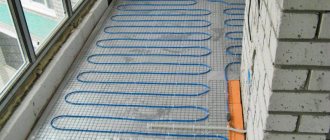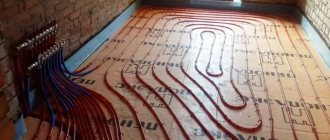Home/Types of heated floors/Water heated floor. Installation of a warm water floor./Calculation of a pipe for a heated floor: online calculator and formulas
Every year new technologies are created for the arrangement and comfort of housing. Thus, not long ago a new innovative design was created for insulating water heated floors. This model has gained great popularity in use in a short time, as it can serve as the main or additional source of heat supply to the room. This system is very easy to use and has many advantages compared to other heating designs. But before installing this equipment, you need to know how to calculate pipes for heated floors and other materials.
General recommendations before installing the system
Before purchasing a water heating system, you need to create a heat map of your home with the help of a specialist. Such a map will help identify heat loss in the room. Thus, if they amount to more than 100 watts per square meter, then before calculating the length of the pipe, you need to insulate the building.
You can calculate a warm water floor yourself using a calculator. But the important point here is that the heating system cannot be placed under large furniture and stationary equipment. Otherwise, the heating system will quickly fail. But at the same time, the water structure must still occupy at least 70% of the floor area, otherwise the room will be poorly heated.
Also, the efficiency of heating will depend on the requirements for the premises.
Basic calculations
Determining the required power of the system will help you calculate the pipe for the heated floor, select a pump and collector for the cottage heating system.
Heat loss calculation
The required power of thermal circuits (M) depends on heat loss (Q) and is determined by the formula:
M = Q×1.2
Heat escapes through external walls, ceilings, and windows.
On a note! Since in our case the floor will be heated, heat loss through it is not taken into account.
Proportion of heat loss through different house designs Source domekonom.su
See also: Catalog of house projects with a boiler room
To determine losses, you need to know the thermal resistance (R) values of all structures. They are easy to calculate if you divide the thickness of a wall or other structure by the thermal conductivity coefficient, which is different for each material. It is found in the table:
| Materials | Thermal conductivity coefficient, W/(m°*C) |
| Reinforced concrete | 1,7 |
| Sand-lime brick | 0,7 |
| Ceramic brick | 0,44 |
| Aerated concrete and foam concrete | 0,26 |
| Expanded clay concrete | 0,4 |
| Tree | 0,18 |
| Mineral wool | 0,055 |
| Expanded polystyrene | 0,038 |
For example, if a house is built from timber 20 cm thick, then the thermal resistance of the external walls is calculated as follows:
0.2/0.18 = 1.11 m²°C/W
If the walls are insulated with mineral wool, calculations must be performed both for it and for the façade finishing material. The complexity of the calculations also lies in the fact that heat losses are calculated individually for each structure: the area of openings is subtracted from the area of the walls, the thermal resistance of double-glazed windows and window profiles is determined, the power required to heat the air entering through ventilation ducts is taken into account, etc.
The thermal resistance of a wall is the sum of the resistances of all its layers Source www.bazalt-most.ru
See also: Catalog of companies that specialize in the installation of internal engineering systems
That is why it would be better to trust the specialists. But particularly thrifty and time-poor homeowners can use the following formula:
Q = 1/R x (Tv - Tn) x S,
where S is the area of the structure, and Tv and Tn are the indoor and outdoor temperatures (minimum).
Let's show with an example how to calculate a warm floor. Let’s assume that the area of the external walls in the room of our house made of timber is 50 m², the minimum winter temperature outside is -30°, and inside should be +24°. Then:
Q = 1/1.11 x (24 – (-30)) x 50 = 2432 W
But that’s not all, you should take into account the orientation of the room according to the cardinal direction. If it faces south, leave the value unchanged; if it faces north, multiply it by a factor of 1.1; if it faces west or east, multiply it by 1.05.
Then, using the same formula, we separately calculate heat loss through windows, adding up their area, through the front door, ceiling, ventilation system (by air volume per unit time). And we summarize all the results. And so on for each room, especially if they are supposed to be maintained at different temperatures.
A detailed house plan with dimensions will simplify the task Source 2.bp.blogspot.com
Let's assume that we end up with 12500 watts. We multiply by 1.2 and get the required system power of 15,000 W or 15 kW.
What room requirements must be met when installing the system?
During installation work, the most correct decision would be when the pipeline is installed at the initial stage of construction of the floors. This method is 30–40% more economical than the radiator method. It is also possible to install a water heating structure in a ready-made room, but to save the family budget, you should pay attention to the following requirements:
- The height of the ceilings should allow the installation of heated floors with a thickness of 8 to 20 centimeters.
- The height of doorways should not be less than 210 centimeters.
- To install a cement-sand screed, the floor must be more durable.
- To avoid airiness of the contours and high hydraulic resistance, the surface for the base of the structure must be flat and clean. The permissible level of unevenness is no more than 5 millimeters.
And also in the building itself or in individual rooms where the heating system will be installed, plastering work must be done and all windows must be installed.
Water floor power calculation
Calculations of the heating water system must be made extremely carefully. Any mistakes in the future can lead to additional costs, since they can be corrected only with complete or partial dismantling of the screed, and this can damage the interior decoration of the room.
Before you start calculating the amount of power you need to know several parameters .
Parameters for a water floor
The power of the heating system is influenced by several factors, such as:
- diameter of pipelines;
- pump power;
- room area;
- type of flooring.
These parameters also help to calculate the length of pipes for underfloor heating and their branches for heating rooms.
But how is power calculated?
Power calculation method
It is very difficult to independently calculate power, since it requires skill and experience. For these reasons, it is better to order it from the appropriate organization where process engineers work. If, however, the calculation is made independently, then the average value is 100 watts per square meter. This technique is used in multi-story buildings.
In private houses, the average power value will depend on the area of the building. Thus, experts have compiled the following indicators:
- area up to 150 sq. m. – 120 W/m2;
- area from 150 to 300 sq. m. – 100 W/m2;
- area from 300 to 500 sq. m. – 90 W/m2.
Having considered the methodology for calculating power, you need to calculate the number of pipes. But to do this, you should first familiarize yourself with the methods of installing them.
Assessment of technical properties when choosing pipes
Due to non-standard operating conditions, high demands are placed on the material and size of the water floor coil:
- chemical inertness , resistance to corrosive processes;
- the presence of an absolutely smooth internal coating , not prone to the formation of limescale build-ups;
- strength - the walls are constantly exposed to the coolant from the inside, and the screed from the outside; the pipe must withstand a pressure of up to 10 bar.
It is desirable that the heating branch have a small specific gravity. The water floor pie already places a significant load on the ceiling, and a heavy pipeline will only aggravate the situation.
According to SNiP, the use of welded pipes in closed heating systems is prohibited, regardless of the type of seam: spiral or straight
Three categories of rolled pipes meet the listed requirements to one degree or another: cross-linked polyethylene, metal-plastic, and copper.
Option #1 - cross-linked polyethylene (PEX)
The material has a mesh wide-cell structure of molecular bonds. Modified polyethylene differs from conventional polyethylene in the presence of both longitudinal and transverse ligaments. This structure increases specific gravity, mechanical strength and chemical resistance.
A water circuit made of PEX pipes has a number of advantages:
- high elasticity , allowing the coil to be laid with a small bend radius;
- safety – when heated, the material does not emit harmful components;
- heat resistance : softening – from 150 °C, melting – 200 °C, combustion – 400 °C;
- maintains structure during temperature fluctuations;
- resistance to damage - biological destroyers and chemical reagents.
The pipeline retains its original throughput - no sediment is deposited on the walls. The estimated service life of a PEX circuit is 50 years.
The disadvantages of cross-linked polyethylene include: fear of sunlight, the negative effects of oxygen when it penetrates inside the structure, the need for rigid fixation of the coil during installation
There are four product groups:
- PEX-a – peroxide cross-linking . The most durable and uniform structure with a bond density of up to 75% is achieved.
- PEX-b – silane cross-linking . The technology uses silanides - toxic substances that are unacceptable for household use. Manufacturers of plumbing products replace it with a safe reagent. Pipes with a hygienic certificate are acceptable for installation. Crosslink density – 65-70%.
- PEX-c – radiation method . Polyethylene is irradiated with a stream of gamma rays or an electron. As a result, the bonds are compacted up to 60%. Disadvantages of PEX-c: unsafe use, uneven cross-linking.
- PEX-d – nitriding . The reaction to create a network occurs due to nitrogen radicals. The output is a material with a crosslink density of about 60-70%.
The strength characteristics of PEX pipes depend on the method of cross-linking polyethylene.
If you choose pipes made from cross-linked polyethylene, we recommend that you familiarize yourself with the rules for installing a heated floor system made from them.
Option #2 - metal-plastic
The leader in rolled pipes for installing heated floors is metal-plastic. Structurally, the material includes five layers.
The inner coating and outer shell are high-density polyethylene, which gives the pipe the necessary smoothness and heat resistance. Intermediate layer – aluminum spacer
The metal increases the strength of the line, reduces the rate of thermal expansion and acts as an anti-diffusion barrier - it blocks the flow of oxygen to the coolant.
Features of metal-plastic pipes:
- good thermal conductivity;
- ability to maintain a given configuration;
- operating temperature with preservation of properties – 110 °C;
- low specific gravity;
- noiseless movement of the coolant;
- safety of use;
- corrosion resistance;
- service life – up to 50 years.
The disadvantage of composite pipes is the inadmissibility of bending about the axis. Repeated twisting risks damaging the aluminum layer. We recommend that you familiarize yourself with the correct technology for installing metal-plastic pipes, which will help avoid damage.
Option #3 - copper pipes
In terms of technical and operational characteristics, yellow metal will be the best choice. However, its demand is limited by its high cost.
Compared to synthetic pipelines, the copper circuit wins on several points: thermal conductivity, thermal and physical strength, unlimited bending variability, absolute impermeability to gases
In addition to being expensive, copper piping has an additional disadvantage - the complexity of installation. To bend the contour you will need a press machine or pipe bender.
Option #4 - polypropylene and stainless steel
Sometimes a heating branch is created from polypropylene or stainless steel corrugated pipes. The first option is affordable, but quite rigid in bending - the minimum radius is eight times the diameter of the product.
This means that pipes with a standard size of 23 mm will have to be placed at a distance of 368 mm from each other - an increased laying step will not ensure uniform heating.
Stainless steel pipes have high thermal conductivity and good flexibility. Disadvantages: fragility of sealing rubber bands, creation of strong hydraulic resistance by corrugation
Methods for installing pipelines for a water floor
Before installing pipes, you need to plan their location. There are several methods, which are divided into the following forms:
- a snail of two bends;
- snake;
- double snake;
- corner snake.
Snail pipe laying is used in rectangular or square rooms. With this installation, heat is evenly distributed over the entire floor surface.
Snake laying is used for long and small rooms.
Calculation of the amount of pipeline for the heating system will depend on the chosen form of installation.
How to determine the optimal room temperature
In this case, no special difficulties arise. For orientation, you can use the recommended values, or come up with your own. Moreover, the floor covering must be taken into account.
The living room floor should be heated to 29 degrees. At a distance of more than half a meter from the external walls, the floor temperature should reach 35 degrees. If there is constantly high humidity in the room, you will need to heat the floor surface to 33 degrees.
If the house has wooden parquet, the floor should not be heated above 27 degrees, as the parquet may deteriorate.
Carpet is capable of retaining heat; it makes it possible to increase the temperature by about 4–5 degrees.
How to calculate the pipe pitch for a water floor
Pitch is an indicator of the distance between pipes when installing a heating system.
The optimal step using a pipe is when the floor is heated evenly over the entire area. But here it should be taken into account that the step towards the edge should be no more than 10 centimeters, and in the center no less than 15 centimeters.
The following table will help you independently calculate the required pipeline length for the selected step.
[jtrt_tables id=»1108″] For effective floor heating, the interval between steps should not be more than 30 centimeters.
Outline length
In order for the heating system to be more efficient in heating the room, the optimal length of the circuit should not be higher than 80 meters. Since only in this case can the design create the necessary circulation and pressure in the heating system. But what to do if the calculations for the room require 130 - 140 meters of pipe? In this case, you will need to make several contours. Thus, if you need to install 160 meters of pipe, then you need to divide it into 80 meters and make two separate circuits.
They do not have to be the same in size, since, according to experts, the difference can be up to 14 meters.
The calculation of a pipe for a warm water floor also depends on their models.
Pipe models for circuits
According to the recommendations of experts, the length of the pipeline laying form depends on the following pipe models .
- Made of metal-plastic and polyethylene with a diameter of 16 millimeters, the circuit can reach 100 meters.
- The maximum limit for a contour of polyethylene pipes of 18 millimeters reaches 120 meters.
- A circuit of 120 - 125 meters is used from plastic pipelines of 20 millimeters.
The calculation of a pipe for a heated floor depends not only on the manufacturing material, but also on the diameter.
Type of flooring
The finish affects the efficiency of the system. Optimal thermal conductivity of tiles and porcelain stoneware - the surface heats up quickly. A good indicator of the efficiency of the water circuit when using laminate and linoleum without a thermal insulation layer. Wooden coverings have the lowest thermal conductivity.
The degree of heat transfer also depends on the filling material. The system is most effective when using heavy concrete with natural aggregate, for example, fine sea pebbles.
The cement-sand mortar provides an average level of heat transfer when the coolant is heated to 45 ° C. The efficiency of the circuit drops significantly when installing a semi-dry screed
When calculating pipes for heated floors, you should take into account the established standards for the temperature regime of the coating:
- 29 °C – living room;
- 33 °C – rooms with high humidity;
- 35 °C – passage zones and cold zones – areas along the end walls.
The climatic features of the region will play an important role in determining the density of the water circuit. When calculating heat loss, the minimum temperature in winter must be taken into account.
As practice shows, preliminary insulation of the entire house will help reduce the load. It makes sense to first thermally insulate the room, and then start calculating heat loss and parameters of the pipe circuit.











